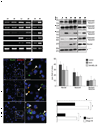Regulation of the embryonic morphogen Nodal by Notch4 facilitates manifestation of the aggressive melanoma phenotype
- PMID: 21159651
- PMCID: PMC3057934
- DOI: 10.1158/0008-5472.CAN-10-0705
Regulation of the embryonic morphogen Nodal by Notch4 facilitates manifestation of the aggressive melanoma phenotype
Abstract
Metastatic melanoma is an aggressive skin cancer associated with poor prognosis. The reactivation of the embryonic morphogen Nodal in metastatic melanoma has previously been shown to regulate the aggressive behavior of these tumor cells. During the establishment of left-right asymmetry in early vertebrate development, Nodal expression is specifically regulated by a Notch signaling pathway. We hypothesize that a similar relationship between Notch and Nodal may be reestablished in melanoma. In this study, we investigate whether cross talk between the Notch and Nodal pathways can explain the reactivation of Nodal in aggressive metastatic melanoma cells. We show a molecular link between Notch and Nodal signaling in the aggressive melanoma cell line MV3 via the activity of an RBPJ-dependent Nodal enhancer element. We show a precise correlation between Notch4 and Nodal expression in multiple aggressive cell lines but not poorly aggressive cell lines. Surprisingly, Notch4 is specifically required for expression of Nodal in aggressive cells and plays a vital role both in the balance of cell growth and in the regulation of the aggressive phenotype. In addition, Notch4 function in vasculogenic mimicry and anchorage-independent growth in vitro is due in part to Notch4 regulation of Nodal. This study identifies an important role for cross talk between Notch4 and Nodal in metastatic melanoma, placing Notch4 upstream of Nodal, and offers a potential molecular target for melanoma therapy.
©2010 AACR.
Conflict of interest statement
Potential conflicts of interest: Commercial research grant from Acceleron Pharma (M.J.C. Hendrix); Patent to target Nodal (M.J.C. Hendrix, E.A. Seftor, L.M. Postovit)
Figures





References
-
- Hendrix MJ, Seftor EA, Seftor RE, Kasemeier-Kulesa J, Kulesa PM, Postovit LM. Reprogramming metastatic tumour cells with embryonic microenvironments. Nat Rev Cancer. 2007;7:246–255. - PubMed
-
- Topczewska JM, Postovit LM, Margaryan NV, et al. Embryonic and tumorigenic pathways converge via Nodal signaling: role in melanoma aggressiveness. Nat Med. 2006;12:925–932. - PubMed
-
- Massi D, Tarantini F, Franchi A, et al. Evidence for differential expression of Notch receptors and their ligands in melanocytic nevi and cutaneous malignant melanoma. Mod Pathol. 2006;19:246–254. - PubMed
Publication types
MeSH terms
Substances
Grants and funding
LinkOut - more resources
Full Text Sources
Other Literature Sources
Medical
Molecular Biology Databases

